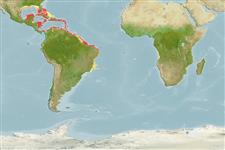Issue
Matsuura (2003: Ref. 53032) places this species in the genus Rhinesomus.
Environment: milieu / climate zone / depth range / distribution range
ນິເວດວິທະຍາ
ສັດທະເລ ກ່ຽວກັນຫີນ; ລະດັບຄວາມເລິກ 3 - 50 m (Ref. 11227). Subtropical; 32°N - 35°S, 99°W - 14°W
Western Atlantic: Florida (USA), Bahamas, and southern Gulf of Mexico to Brazil. Eastern Atlantic: Ascension Island (Ref. 3696).
ຂະໜາດ / ນ້ຳໜັກ / Age
Maturity: Lm ? range ? - ? cm
Max length : 48.0 cm TL ຕົວຜູ້/ບໍ່ມີເພດ; (Ref. 7251); common length : 20.0 cm TL ຕົວຜູ້/ບໍ່ມີເພດ; (Ref. 5217)
Whitish with numerous small black spots on carapace, caudal peduncle and caudal fin; lips whitish; bases of dorsal, anal and pectoral fins blackish; large adults with black spots missing from three small areas in a diagonal row anteriorly on body at level of eye, appearing as three white spots (Ref. 13442).
Found in clear water around coral reefs. Sometimes under ledges and near small holes (Ref. 9710). Feeds on a variety of small bottom invertebrates such as mollusks, crustaceans, starfishes, sea urchins, sea cucumbers, sessile tunicates, sea grasses (Ref. 3696), algae, crabs and brittle stars (Ref. 13442). Toxins released when excited kills other fishes (Ref. 5521). Probably marketed fresh locally (Ref. 3696).
Life cycle and mating behavior
Maturities | ການສືບພັນ | Spawnings | Egg(s) | Fecundities | ຕົວອ່ອນ
Robins, C.R. and G.C. Ray, 1986. A field guide to Atlantic coast fishes of North America. Houghton Mifflin Company, Boston, U.S.A. 354 p. (Ref. 7251)
IUCN Red List Status (Ref. 130435)
Threat to humans
Reports of ciguatera poisoning (Ref. 30911)
Human uses
Warning: mysqli::__construct(): (HY000/1040): Too many connections in /var/www/html/includes/func_getlabel.php on line 46
Can't connect to MySQL database (fbapp). Errorcode: Too many connections
